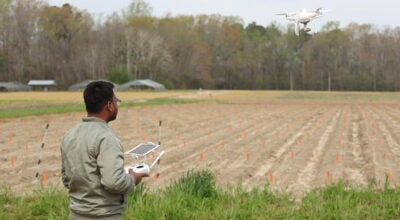Hyperbaric now available in Suffolk
Published 11:11 pm Monday, February 18, 2013

Ronnie Preddy lies in the hyperbaric chamber at Sentara Obici Hospital last week. The treatments have helped heal sores Preddy developed after radiation therapy for cancer.
Ronnie Preddy was prepped with a hospital gown, a blanket and a sippy cup full of water as registered nurse Eldon “Jack” Jackson slid Preddy’s gurney into one of two hyperbaric chambers at Sentara Obici Hospital.
Jackson sealed the door, turned up the oxygenated pressure and set a timer for 90 minutes, then used a phone mounted to the outside of the chamber to communicate with Preddy.
“What do you want on TV today?” Jackson asked, referring to a screen mounted above the chamber.
Preddy, who is nearing his final treatment, has been among the first to benefit from the new hyperbaric medicine program at Sentara Obici Hospital, which began operating in September.
Most patients need at least 10 hyperbaric treatments, and sometimes as many as 60. Bringing the program to Obici ensures patients in Suffolk and Western Tidewater can access the specialized treatment more easily than the sites at Sentara Leigh Hospital in Norfolk or Sentara Port Warwick in Newport News.
“It has really helped the community,” said Dr. Charles Graffeo, medical director for the hyperbaric medicine program. “Having a facility close enough to home for folks who live in Western Tidewater is very helpful.”
In the hyperbaric chamber, patients are exposed to pressurized, 100-percent oxygen. It is useful for treating wounds that haven’t healed, poor circulation, some types of infections, compromised grafts or flaps from plastic surgery and emergencies like carbon monoxide poisoning, among other conditions. The extra oxygen helps inhibit the growth of bacteria, decrease swelling and promote the growth of tiny blood vessels.
Preddy is a cancer survivor, but the radiation treatment left him with a number of painful sores in his throat and mouth.
“It was just unbelievable pain,” he said. He was taking nearly two dozen pain pills a day before his doctor referred him to the hyperbaric treatments.
Now, he’s down to only one pain pill a day, half in the morning and half in the evening.
“That’s how much it’s healed my mouth and my throat,” he said. “I don’t know what I would have done. I really stand by it.”
Cancer survivors are often beneficiaries of the hyperbaric program, Graffeo said.
“Skin changes associated with radiation therapy create a difficult environment for a wound to heal,” Graffeo said. “It becomes very leathery and loses its structural integrity.”
The treatments are also remarkably side effect-free, but common problems include pressure in the ears and confinement anxiety, Graffeo said.
The pressure is “similar to taking a plane flight” and can usually be solved by swallowing or yawning, he said.
The program at Obici is serving fewer than 25 patients, and they are always looking for more, Graffeo said.
“There is a significant difference in healing a wound,” he said. “It’s a multifaceted, multidisciplinary approach to wound healing. We can now do that in Western Tidewater.”






